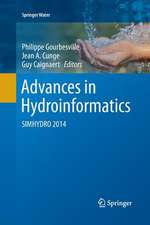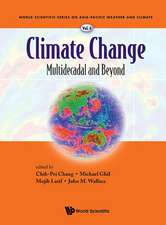Climate Change: The Social and Scientific Construct
Editat de Suhaib A. Bandhen Limba Engleză Hardback – 5 mar 2022
The difference between climate change now and in the past is that of sudden and disproportionate disruption of the natural energy dynamics by the changing consumption patterns of billions of human beings who have polluted terrestrial and aquatic ecosystems. The picture that emerges from the exhaustive analysis of international data drawn from the most reliable sources indicates that we have possibly gained access to the gateway of extinction and it is time that we take corrective steps immediately.
Global climate change is further altering our relationship with the environment, modifying relatively stable climatic factors and making them uncertain, unpredictable, and threatening. Changes in land use and an increasing demand for water resources due toclimate change have affected the capacity of ecosystems to sustain food production, ensure the supply of freshwater resources, provide ecosystem services, and promote rural multi-functionality. Ensuring food production does not just depend on increasing water efficiency, promoting climate resilient crop production, or reducing land-use competition for urbanization but also on a more suitable and stable climate as the changes in climatic factors like precipitation, temperature, radiation, evaporation, and wind bring about some major shifts in global food supplies.
According to Special Report on Emission Scenarios (SRES), focused on greenhouse gas emissions projections, and Representative Concentration Pathways (RCPs) conducted by the Intergovernmental Panel on Climate Change (IPCC), climate change increases the risk of simultaneous crop failures (including corn, rice, legumes, and vegetables) if irrigation systems are not fully adapted to water stress situations. A changing climate could have many adverse impacts on other sectors of our environment.
This book offers concrete, up-to-date, and appropriate study cum research material for students, researchers, academicians and policymakers. It will be of a greater interest to students and researchers in the field of environmental science, agriculture science, agronomy, and sustainable development.
| Toate formatele și edițiile | Preț | Express |
|---|---|---|
| Paperback (1) | 849.85 lei 18-23 zile | +72.71 lei 7-13 zile |
| Springer International Publishing – 6 mar 2023 | 849.85 lei 18-23 zile | +72.71 lei 7-13 zile |
| Hardback (1) | 1011.27 lei 3-5 săpt. | |
| Springer International Publishing – 5 mar 2022 | 1011.27 lei 3-5 săpt. |
Preț: 1011.27 lei
Preț vechi: 1233.26 lei
-18% Nou
Puncte Express: 1517
Preț estimativ în valută:
193.51€ • 206.93$ • 161.34£
193.51€ • 206.93$ • 161.34£
Carte disponibilă
Livrare economică 27 martie-10 aprilie
Preluare comenzi: 021 569.72.76
Specificații
ISBN-13: 9783030862893
ISBN-10: 3030862895
Pagini: 390
Ilustrații: VI, 390 p. 90 illus., 78 illus. in color.
Dimensiuni: 155 x 235 mm
Greutate: 0.77 kg
Ediția:1st ed. 2022
Editura: Springer International Publishing
Colecția Springer
Locul publicării:Cham, Switzerland
ISBN-10: 3030862895
Pagini: 390
Ilustrații: VI, 390 p. 90 illus., 78 illus. in color.
Dimensiuni: 155 x 235 mm
Greutate: 0.77 kg
Ediția:1st ed. 2022
Editura: Springer International Publishing
Colecția Springer
Locul publicării:Cham, Switzerland
Cuprins
Understanding climate change.- Scientific opinion on climate change.- Public perspective of climate change.- Predictors of public climate change awareness and risk perception around the world.- Drivers of Climate change.
Notă biografică
Dr Suhaib A. Bandh is an Assistant Professor in Department of Higher Education, Government of Jammu and Kashmir at Governement Degree College DH Pora. Dr Bandh is the President and founder of Academy of EcoScience besides being a life member of the Academy of Plant Sciences India and National Environmental Science Academy India. Dr Bandh, a recipient of many awards, has participated in several national and international conferences held by different reputed scientific bodies in India and abroad. He has several scientific publications to his credit, published in some highly reputed and impacted journals, which attest to his scientific insight, fine experimental skills and outstanding writing skills. Dr Bandh has recently edited and authored many books like Freshwater Microbiology: Perspectives of Lake Bacterial Dynamics, Environmental Management: Environmental Issue, awareness and abatement, Perspectives of Environmental Science, Climate Change and Microbial Diversity: Advances and Challenges, Climate Change and Microbes: Impacts and Vulnerability, Sustainable Agriculture: Technical Progressions and Transitions with some leading scholarly pyblishing houses including SPRINGER NATURE, ELSEVIER Inc USA, CALLISTO REFERENCES and AAP/CRC, A TAYLOR & FRANCIS GROUP. Dr. Bandh is an Academic Editor of the Journal Advances in Agriculture published by HINDAWI. He has also edited a special issue on Ecology and Biotechnological Applications of Biofilm in BioMed Research International with HINDAWI
Textul de pe ultima copertă
Beginning in the second half of the twentieth century, the impacts of climate change have been fierce, causing loss of human life and irreparable destruction to natural and man-made infrastructure in many parts of the world.
The difference between climate change now and in the past is that of sudden and disproportionate disruption of the natural energy dynamics by the changing consumption patterns of billions of human beings who have polluted terrestrial and aquatic ecosystems. The picture that emerges from the exhaustive analysis of international data drawn from the most reliable sources indicates that we have possibly gained access to the gateway of extinction and it is time that we take corrective steps immediately.
Global climate change is further altering our relationship with the environment, modifying relatively stable climatic factors and making them uncertain, unpredictable, and threatening. Changes in land use and an increasing demand for water resources due toclimate change have affected the capacity of ecosystems to sustain food production, ensure the supply of freshwater resources, provide ecosystem services, and promote rural multi-functionality. Ensuring food production does not just depend on increasing water efficiency, promoting climate resilient crop production, or reducing land-use competition for urbanization but also on a more suitable and stable climate as the changes in climatic factors like precipitation, temperature, radiation, evaporation, and wind bring about some major shifts in global food supplies.
According to Special Report on Emission Scenarios (SRES), focused on greenhouse gas emissions projections, and Representative Concentration Pathways (RCPs) conducted by the Intergovernmental Panel on Climate Change (IPCC), climate change increases the risk of simultaneous crop failures (including corn, rice, legumes, and vegetables) if irrigation systems are not fully adapted to water stress situations. A changing climate could have many adverse impacts on other sectors of our environment.
This book offers concrete, up-to-date, and appropriate study cum research material for students, researchers, academicians and policymakers. It will be of a greater interest to students and researchers in the field of environmental science, agriculture science, agronomy, and sustainable development.
The difference between climate change now and in the past is that of sudden and disproportionate disruption of the natural energy dynamics by the changing consumption patterns of billions of human beings who have polluted terrestrial and aquatic ecosystems. The picture that emerges from the exhaustive analysis of international data drawn from the most reliable sources indicates that we have possibly gained access to the gateway of extinction and it is time that we take corrective steps immediately.
Global climate change is further altering our relationship with the environment, modifying relatively stable climatic factors and making them uncertain, unpredictable, and threatening. Changes in land use and an increasing demand for water resources due toclimate change have affected the capacity of ecosystems to sustain food production, ensure the supply of freshwater resources, provide ecosystem services, and promote rural multi-functionality. Ensuring food production does not just depend on increasing water efficiency, promoting climate resilient crop production, or reducing land-use competition for urbanization but also on a more suitable and stable climate as the changes in climatic factors like precipitation, temperature, radiation, evaporation, and wind bring about some major shifts in global food supplies.
According to Special Report on Emission Scenarios (SRES), focused on greenhouse gas emissions projections, and Representative Concentration Pathways (RCPs) conducted by the Intergovernmental Panel on Climate Change (IPCC), climate change increases the risk of simultaneous crop failures (including corn, rice, legumes, and vegetables) if irrigation systems are not fully adapted to water stress situations. A changing climate could have many adverse impacts on other sectors of our environment.
This book offers concrete, up-to-date, and appropriate study cum research material for students, researchers, academicians and policymakers. It will be of a greater interest to students and researchers in the field of environmental science, agriculture science, agronomy, and sustainable development.
Caracteristici
Discusses dimensions of climate change, incl. drivers, scenarios, models, economic risks, and impact evaluation Caters to the needs of students as well as academics with focus on the social and scientific construct of climate change Includes several illustrations, statistical data, and figures to highlight the discussed dimensions of climate change






















